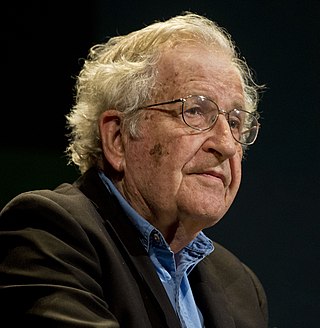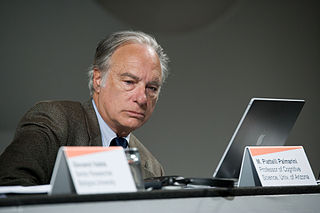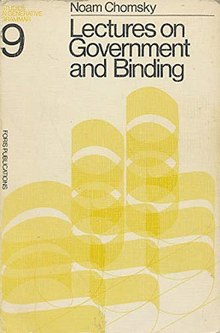
In linguistics, syntax is the study of how words and morphemes combine to form larger units such as phrases and sentences. Central concerns of syntax include word order, grammatical relations, hierarchical sentence structure (constituency), agreement, the nature of crosslinguistic variation, and the relationship between form and meaning (semantics). There are numerous approaches to syntax that differ in their central assumptions and goals.

Universal grammar (UG), in modern linguistics, is the theory of the innate biological component of the language faculty, usually credited to Noam Chomsky. The basic postulate of UG is that there are innate constraints on what the grammar of a possible human language could be. When linguistic stimuli are received in the course of language acquisition, children then adopt specific syntactic rules that conform to UG. The advocates of this theory emphasize and partially rely on the poverty of the stimulus (POS) argument and the existence of some universal properties of natural human languages. However, the latter has not been firmly established, as some linguists have argued languages are so diverse that such universality is rare, and the theory of universal grammar remains controversial among linguists.
In linguistics, transformational grammar (TG) or transformational-generative grammar (TGG) is part of the theory of generative grammar, especially of natural languages. It considers grammar to be a system of rules that generate exactly those combinations of words that form grammatical sentences in a given language and involves the use of defined operations to produce new sentences from existing ones.
In linguistics, X-bar theory is a model of phrase-structure grammar and a theory of syntactic category formation that was first proposed by Noam Chomsky in 1970 reformulating the ideas of Zellig Harris (1951), and further developed by Ray Jackendoff, along the lines of the theory of generative grammar put forth in the 1950s by Chomsky. It attempts to capture the structure of phrasal categories with a single uniform structure called the X-bar schema, basing itself on the assumption that any phrase in natural language is an XP that is headed by a given syntactic category X. It played a significant role in resolving issues that phrase structure rules had, representative of which is the proliferation of grammatical rules, which is against the thesis of generative grammar.
Deep structure and surface structure are concepts used in linguistics, specifically in the study of syntax in the Chomskyan tradition of transformational generative grammar.

Generative grammar, or generativism, is a linguistic theory that regards linguistics as the study of a hypothesised innate grammatical structure. It is a biological or biologistic modification of earlier structuralist theories of linguistics, deriving from logical syntax and glossematics. Generative grammar considers grammar as a system of rules that generates exactly those combinations of words that form grammatical sentences in a given language. It is a system of explicit rules that may apply repeatedly to generate an indefinite number of sentences which can be as long as one wants them to be. The difference from structural and functional models is that the object is base-generated within the verb phrase in generative grammar. This purportedly cognitive structure is thought of as being a part of a universal grammar, a syntactic structure which is caused by a genetic mutation in humans.
In linguistics, the minimalist program is a major line of inquiry that has been developing inside generative grammar since the early 1990s, starting with a 1993 paper by Noam Chomsky.
Theta roles are the names of the participant roles associated with a predicate: the predicate may be a verb, an adjective, a preposition, or a noun. If an object is in motion or in a steady state as the speakers perceives the state, or it is the topic of discussion, it is called a theme. The participant is usually said to be an argument of the predicate. In generative grammar, a theta role or θ-role is the formal device for representing syntactic argument structure—the number and type of noun phrases—required syntactically by a particular verb. For example, the verb put requires three arguments.
Principles and parameters is a framework within generative linguistics in which the syntax of a natural language is described in accordance with general principles and specific parameters that for particular languages are either turned on or off. For example, the position of heads in phrases is determined by a parameter. Whether a language is head-initial or head-final is regarded as a parameter which is either on or off for particular languages. Principles and parameters was largely formulated by the linguists Noam Chomsky and Howard Lasnik. Many linguists have worked within this framework, and for a period of time it was considered the dominant form of mainstream generative linguistics.

Syntactic Structures is an important work in linguistics by American linguist Noam Chomsky, originally published in 1957. A short monograph of about a hundred pages, it is recognized as one of the most significant and influential linguistic studies of the 20th century. It contains the now-famous sentence "Colorless green ideas sleep furiously", which Chomsky offered as an example of a grammatically correct sentence that has no discernible meaning, thus arguing for the independence of syntax from semantics.
In linguistics, linguistic competence is the system of unconscious knowledge that one knows when they know a language. It is distinguished from linguistic performance, which includes all other factors that allow one to use one's language in practice.
The generative approach to second language (L2) acquisition (SLA) is a cognitive based theory of SLA that applies theoretical insights developed from within generative linguistics to investigate how second languages and dialects are acquired and lost by individuals learning naturalistically or with formal instruction in foreign, second language and lingua franca settings. Central to generative linguistics is the concept of Universal Grammar (UG), a part of an innate, biologically endowed language faculty which refers to knowledge alleged to be common to all human languages. UG includes both invariant principles as well as parameters that allow for variation which place limitations on the form and operations of grammar. Subsequently, research within the Generative Second-Language Acquisition (GenSLA) tradition describes and explains SLA by probing the interplay between Universal Grammar, knowledge of one's native language and input from the target language. Research is conducted in syntax, phonology, morphology, phonetics, semantics, and has some relevant applications to pragmatics.
Langueandparole is a theoretical linguistic dichotomy distinguished by Ferdinand de Saussure in his Course in General Linguistics.

Biolinguistics can be defined as the study of biology and the evolution of language. It is highly interdisciplinary as it is related to various fields such as biology, linguistics, psychology, anthropology, mathematics, and neurolinguistics to explain the formation of language. It is important as it seeks to yield a framework by which we can understand the fundamentals of the faculty of language. This field was first introduced by Massimo Piattelli-Palmarini, professor of Linguistics and Cognitive Science at the University of Arizona. It was first introduced in 1971, at an international meeting at the Massachusetts Institute of Technology (MIT). Biolinguistics, also called the biolinguistic enterprise or the biolinguistic approach, is believed to have its origins in Noam Chomsky's and Eric Lenneberg's work on language acquisition that began in the 1950s as a reaction to the then-dominant behaviorist paradigm. Fundamentally, biolinguistics challenges the view of human language acquisition as a behavior based on stimulus-response interactions and associations. Chomsky and Lenneberg militated against it by arguing for the innate knowledge of language. Chomsky in 1960s proposed the Language Acquisition Device (LAD) as a hypothetical tool for language acquisition that only humans are born with. Similarly, Lenneberg (1967) formulated the Critical Period Hypothesis, the main idea of which being that language acquisition is biologically constrained. These works were regarded as pioneers in the shaping of biolinguistic thought, in what was the beginning of a change in paradigm in the study of language.
Merge is one of the basic operations in the Minimalist Program, a leading approach to generative syntax, when two syntactic objects are combined to form a new syntactic unit. Merge also has the property of recursion in that it may be applied to its own output: the objects combined by Merge are either lexical items or sets that were themselves formed by Merge. This recursive property of Merge has been claimed to be a fundamental characteristic that distinguishes language from other cognitive faculties. As Noam Chomsky (1999) puts it, Merge is "an indispensable operation of a recursive system ... which takes two syntactic objects A and B and forms the new object G={A,B}" (p. 2).

Aspects of the Theory of Syntax is a book on linguistics written by American linguist Noam Chomsky, first published in 1965. In Aspects, Chomsky presented a deeper, more extensive reformulation of transformational generative grammar (TGG), a new kind of syntactic theory that he had introduced in the 1950s with the publication of his first book, Syntactic Structures. Aspects is widely considered to be the foundational document and a proper book-length articulation of Chomskyan theoretical framework of linguistics. It presented Chomsky's epistemological assumptions with a view to establishing linguistic theory-making as a formal discipline comparable to physical sciences, i.e. a domain of inquiry well-defined in its nature and scope. From a philosophical perspective, it directed mainstream linguistic research away from behaviorism, constructivism, empiricism and structuralism and towards mentalism, nativism, rationalism and generativism, respectively, taking as its main object of study the abstract, inner workings of the human mind related to language acquisition and production.

In linguistics, the term formalism is used in a variety of meanings which relate to formal linguistics in different ways. In common usage, it is merely synonymous with a grammatical model or a syntactic model: a method for analyzing sentence structures. Such formalisms include different methodologies of generative grammar which are especially designed to produce grammatically correct strings of words; or the likes of Functional Discourse Grammar which builds on predicate logic.
In linguistics, transformational syntax is a derivational approach to syntax that developed from the extended standard theory of generative grammar originally proposed by Noam Chomsky in his books Syntactic Structures and Aspects of the Theory of Syntax. It emerged from a need to improve on approaches to grammar in structural linguistics.

Current Issues in Linguistic Theory is a 1964 book by American linguist Noam Chomsky. It is a revised and expanded version of "The Logical Basis of Linguistic Theory", a paper that Chomsky presented in the ninth International Congress of Linguists held in Cambridge, Massachusetts in 1962. It is a short monograph of about a hundred pages, similar to Chomsky's earlier Syntactic Structures (1957). In Aspects of the Theory of Syntax (1965), Chomsky presents many of its ideas in a more elaborate manner.
The basis of Chomsky's linguistic theory lies in biolinguistics, the linguistic school that holds that the principles underpinning the structure of language are biologically preset in the human mind and hence genetically inherited. He argues that all humans share the same underlying linguistic structure, irrespective of sociocultural differences. In adopting this position Chomsky rejects the radical behaviorist psychology of B. F. Skinner, who viewed speech, thought, and all behavior as a completely learned product of the interactions between organisms and their environments. Accordingly, Chomsky argues that language is a unique evolutionary development of the human species and distinguished from modes of communication used by any other animal species. Chomsky's nativist, internalist view of language is consistent with the philosophical school of "rationalism" and contrasts with the anti-nativist, externalist view of language consistent with the philosophical school of "empiricism", which contends that all knowledge, including language, comes from external stimuli.







